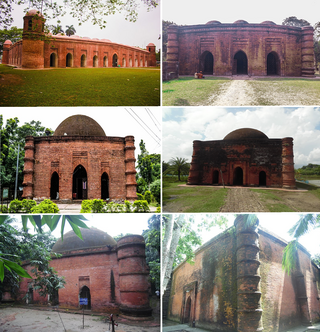
The Mosque City of Bagerhat is a UNESCO World Heritage Site in Bagerhat District, Bangladesh. It contains 360 mosques, public buildings, mausoleums, bridges, roads, water tanks and other public buildings constructed from baked brick. The mosques were built during the Bengal Sultanate in the 15th century, of which the Sixty Dome Mosque is the largest. Other mosques include the Singar Mosque, the Nine Dome Mosque, the Tomb of Khan Jahan, the Bibi Begni Mosque and the Ronvijoypur Mosque. The mosques were built during the governorship of Ulugh Khan Jahan, a Turkic military officer appointed as governor in the Sundarbans by Sultan Mahmud Shah of Bengal.

The Kalyan Minaret is a minaret of the Po-i-Kalyan mosque complex in Bukhara, Uzbekistan and one of the most prominent landmarks in the city.
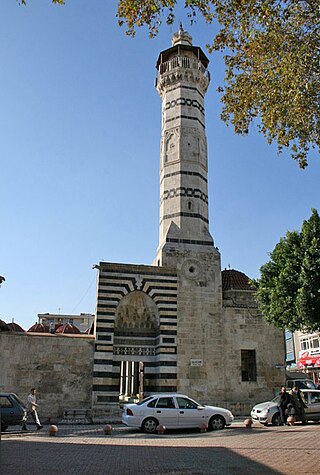
The Great Mosque of Adana, also known as the Ramazanoglu Mosque, is a 16th-century mosque in Adana, Turkey. It forms part of a complex (külliye) that includes a madrasah and a mausoleum (türbe). The complex is on Kızılay street, next to the Ramazanoğlu Hall.
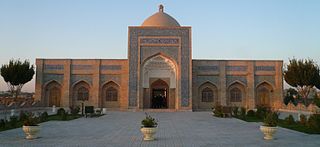
Bahoutdin Architectural Complex is a complex in Bukhara, Uzbekistan, that includes the tomb of Baha-ud-Din Naqshband Bukhari, the founder of the Naqshbandi order, who died in 1389. The ancient name of the location was Kasri Arifon.

The Karabakhlar Mausoleum is a mausoleum located in Garabaghlar village of Kangarli District of Azerbaijan, about 30 kilometers far from the north-western part of Nakhchivan.

The Musalla complex, also known as the Musallah Complex or the Musalla of Gawhar Shah, is a former Islamic religious complex located in Herat, Afghanistan, containing examples of Timurid architecture. Much of the 15th-century complex is in ruins today, and the buildings that still stand are in need of restoration. The complex ruins consist of the five Musallah Minarets of Herat, the Mir Ali Sher Navai mausoleum, the Gawhar Shad Mausoleum, and the ruins of a large mosque and a madrasa complex.

The Vobkent Minaret is a historical monument in the city of Vobkent, in the Bukhara region. It was built in 1198 by Abdulaziz Sadr, a ruler of the Qarakhanid dynasty. It is currently listed in the national register of immovable cultural heritage of Uzbekistan.
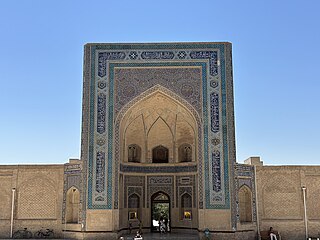
Kalan Mosque is an architectural monument located in Bukhara, Uzbekistan. It was considered one of the largest mosques built on the place of Jame' Mosque. Its current appearance was built in 1514 during the reign of Shaybani Ubaidullah Khan of Bukhara. Currently, the mosque is included in the national list of estate real objects of material and cultural heritage of Uzbekistan.

Abu Hafs Kabir Bukhari Memorial Complex is an architectural monument located in Bukhara. The complex consists of Abu Hafs Kabir Bukhari Mausoleum, Hazrat Imam's cemetery, a mosque, a minaret, a pool and a shrine. The mausoleum is included in the national list of real estate objects of the material and cultural heritage of Uzbekistan.

Khoja Abdulkhalik Gijduvani Complex is an architectural monument located in the city of Gijduvan, Bukhara Region. The complex is located 50 km from the city of Bukhara and was built by Abdukholiq ibn Abdujalil Gijduvani, the founder of the Khojagan sect. The complex consists of the mausoleum of Khoja Abdulkhaliq Gijduvani, the Ulugbek Madrasah, a mosque and a pool. Khoja Abdulkhaliq Gijduvani is the first representative of seven pirs in Bukhara. He became known as Khojai Jahan and founded the school of Sufism. In 1433, Timurid Mirza Ulugbek built a madrasa in front of the shrine of Khoja Abdulkhaliq Gijduvani. In 2003, the 900th anniversary of Khoja Abdulkhaliq Gijduvani was widely celebrated. The Ulugbek madrasah in the complex was distinguished by its appearance. A mosque was built in this complex during the reign of Shaibani Ubaydullah Khan of Bukhara (1539–1550). In 1583, the madrasa and mosque were renovated during the reign of Bukhara Khan Abdullah Khan II (1583–1598). Verses 1-7 of Surah Alaq were mentioned on the facade of the Mirzo Ulugbek madrasah. These notes were written in suls script. However, most of them have collapsed. In 1946, certain part of the Mirzo Ulugbek madrasa records were read and accordingly it was restored. The tombstone of Abdukholiq Gijduvani was made of stone and the eleventh verse of Surah "Mujodala" from the Quran was written on the sides. On the short sides of the tombstone, an epitaph was written. The mosque in the complex of Khoja Abdulkhaliq Gijduvani was rebuilt in 2003. Nowadays, all the conditions for pilgrims have been created in the complex of Khoja Abdulkhaliq Gijduvani.

The Olloqulixon Madrasa or Alla Kouli Khan Madrasa is an architectural monument in Khiva (1834–35). The construction of the madrasa is related to the historical development of the ensemble near the Itchan Kala. The madrasa is located in the eastern part of the Itchan Kala. It is built in the style of a double madrasa, connected with the Ollo-qulixon Tim, the Khojamberdibiy Madrasa, and the Polvon Gate. The Olloqulixon Madrasa is built on an artificial hill, which makes it look taller than the neighboring buildings.

The Bukhara Mosque is a historical monument in Bukhara. It is one of the mosques built for praying during Eid festivals. It was built behind the gate of the prayer hall in the southern part of Bukhara by Shams al-Mulk (1068-1080), who ruled Bukhara under the Kara-Khanid dynasty, in the 11th century. It was built in the 11th-16th centuries.
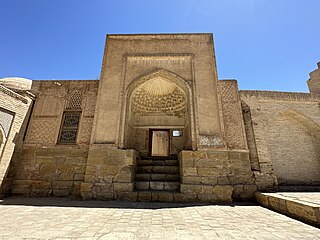
Atoullo Khoja mausoleum is an architectural monument in Bukhara. This shrine is located in the Chor Bakr architectural complex and was built in the 17th century. Mausoleum is included in the national list of real estate objects of material and cultural heritage of Uzbekistan.

The Muin Xalfa Bobo Mausoleum is a 19th-century architectural monument, a mausoleum in Tashkent, Uzbekistan.

Chor Bakr Madrasah is an architectural monument in Bukhara.

Amir Muzaffarkhan Mosque is a mosque located in Bahoutdin Naqshband architectural complex, Kasri Orifon village, Kogon District, Bukhara Region. The mosque was built by Muzaffar bin Nasrullah (1860–1885), the representative of the Mangit dynasty that ruled Bukhara. The mosque is entered through the gate of Bab us-salam. The mosque is located in front of Bahoutdin Naqshband mosque.

Kasri Orifon is one of the ancient villages of Uzbekistan. The settlement is located in Kogon district of Bukhara region. The village of Kasri Hinduvan was renamed as Kasri Orifon in honor of Bahauddin Naqshband, the founder of the Naqshbandi order in the 14th century.
Mullo Mir Mausoleum is an architectural monument in Romitan District, Bukhara Region. The monument was built in the 16th century. It is the mausoleum of Amir Husayn Mulla Mir, and a monastery was built next to it. The house was built in the 90s of the 16th century in the village of Hokimullamir. Amir Husayn Mulla Mir died in 1597. This year is written on the tombstone. In the Mausoleum of Mullo Mir there is a ceremonial building and a room. Mullo Mir is an architectural complex. The house consists of a gable, a wide facade, a dome in the center, and a porch. The area of the building is 26 meters. There are also guest rooms and two-story rooms. The room is rectangular in shape, the width of the main facade together with the corner towers is 20 meters, and the height is 17 meters. In addition, there is a public room in front of the house, which is covered with a dome.

Modarikhan Madrasah is an architectural monument (1566-1567) located opposite the Abdullah Khan Madrasah in Bukhara. Both make up the Koshmadrasa complex. Abdullakhan Madrasah (Bukhara) is located opposite. Currently, it is included in the national list of real estate objects of material and cultural heritage of Uzbekistan.39.77447717366°N 64.40592327683°E

Nadir Devanbegi Madrasah is an architectural monument in Bukhara, Uzbekistan. It was built between 1622 and 1623 by Nadir Devanbegi, the minister of Bukhara Khan, Imam Quli Khan. Nadir Devonbegi madrasah is located in the old city of Bukhara. It is located in the eastern part of the Lyab-i Hauz. Currently, the madrasah is included in the national list of immovable property objects of the material and cultural heritage of Uzbekistan.



















